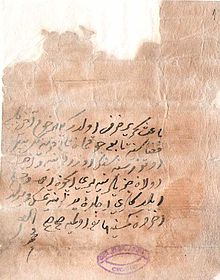Islamic taxes
[9] According to scholar Murat Çizakça, only zakat, jizya and kharaj are mentioned in the Buktasira.Caliph Umar expanded the scope of ushr to include border trade tax.[11] It literally means a tenth part,[12] and it remained in practice in Islamic ruled territories from Spain and North Africa through India and Southeast Asia through the 18th century.[13] Ushur was applied on traders, at a rate of 10% of the value of the merchandise that was either imported or exported across the border controlled by the Islamic state.It applied to non-Muslim traders as well, who were residents of the Islamic state (dhimmi), as well as to non-Muslim traders who were foreigners and wished to sell their merchandise inside the Islamic state.